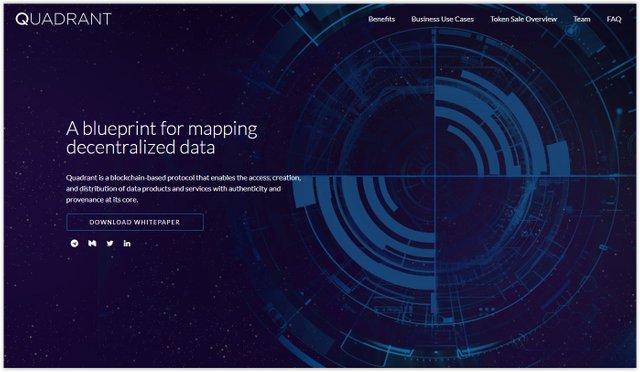Quadrant Protocol - A Blueprint for Mapping Decentralized Data
Vast amounts of authentic data are needed to power today’s algorithms, however the current data economy is uptight with problems. There is an ever-widening gap between those with the resources to gather and store their own data and those that do not. The data these have-nots do have access to often fragment and of questionable authenticity, the kind of data that produces poor results when fed to algorithms. Part of the reason why the data lacks authenticity is because the suppliers of it are not properly incentivized. Fair revenue distribution does not exist for both data producers and vendors. Without a healthy and transparent data economy, the increasing demand for authentic data will not be met.
Quadrant aims to solve these problems by providing a blueprint for mapping unrelated data sources. It will support proof of data authenticity and provenance via data stamping, the creation of “Constellations” (data smart contracts) for disparate data sources, and fair remuneration and incentive sharing. Data Consumers can trust the authenticity of the data they purchase, “Nurseries” (Data Producers) are compensated fairly every time their data is used, and “Pioneers” (Data Vendors) have the incentive to create innovative constellations. This new transparent ecosystem ensures that companies get the authentic data they need.
Quadrant is designed to work with both centralized and decentralized services. The architecture consists of the core Quadrant blockchain, clients (Data Producer, Data Consumer and Anchor), and Guardian Nodes. Quadrant will operate on a Proof of Authority consensus mechanism so that it can handle more transactions, operate at a lower gas price, achieve faster transactions, and restrict malicious nodes from entering data into the network. An external Proof of Work chain will be used as an anchor for security purposes. For the time being, the Ethereum blockchain will be used for anchoring but it can be replaced by any public chain in the future if needed.
There are four major problems facing the data economy:
- A widening AI data gap between the haves and have-nots
- Ubiquitous fake and unauthentic data destroying the usefulness of any algorithm
- Unsustainable data feeds breaking production systems when they go often
- Unfair revenue distribution for the original data producers
What each of the above problems does is plague the stakeholders of the data economy:
• The consumers
• The vendors
• The entities producing the data.
Quadrant will utilize two different currencies for its network: eQuad and QUAD. QUAD is a utility token designed to be used solely on the network. eQuad is an ERC-20-compliant token that will be sold during the Token Generation Event (TGE). It may be converted into QUAD via a gateway when the Quadrant main net is launched. The TGE will have a hard cap of $20,000,000 USD. If the TGE raises over $7,000,000 USD, the contributions garnered will be locked initially and made transferrable over the course of 4 years, with 40% becoming available upon the close of the eQuad token sale and the remaining 60% released annually to be applied towards the Company's objects at a fixed rate of 15%. This is intended to ensure the long-term success of Quadrant while installing practicality to ensure no over-spending in the initial years. And for more details about token sales, visit https://www.quadrantprotocol.com
1,000,000,000 eQuad will be created during the TGE. The tokens will be distributed as follows:
• 40% to the crowd-sale
• 20% to be held by Company
• 20% to the Stakeholders
• 10% to the Reserve
• 10% to the Team.
The International Data Corporation (IDC) put the value of global big data and business analytics revenue at USD 130.1 billion annually in 2016— a number that is expected to grow to over USD 200 billion by 2020. Companies, especially those working with AI, have proven to have an insatiable appetite for data from an ever-increasing variety of sources. Dresner Advisory Services estimates that some 53% of companies utilized big data for analytics purposes in 2017— an increase of 36% from 2015. These companies are using the data to solve complex problems, detect trends and create new products that they will introduce to the market.
The Quadrant Network will be targeted towards these data-hungry companies, starting with a focus on the location intelligence industry. That entre sub-section of big data needs to be cleaned up. Next, Quadrant will be focused on being the alternative data space where companies can access large amounts of compliant data. In the future, the Quadrant Protocol team will seek to expand into IoT and medical data. These are two areas in which compliant and authentic data is critical.
Quadrant will be run similar to a not-for-profit system. It will use the Ethereum gas model to ensure the sustainability of the network without charging excessive fees to derive profit. When Nurseries stamp, they pay a small amount of QUAD which goes to the Guardians as the incentive for maintaining nodes within the network. Users will pay QUAD to create constellations but the total payment for the data within the constellations will go to their owner(s).
Official Website: https://www.quadrantprotocol.com/
ANN Thread: https://bitcointalk.org/index.php?topic=3676988.0
Official Telegram: https://t.me/quadrantprotocol
Author: lkyasilk (https://bitcointalk.org/index.php?action=profile;u=1186099)
